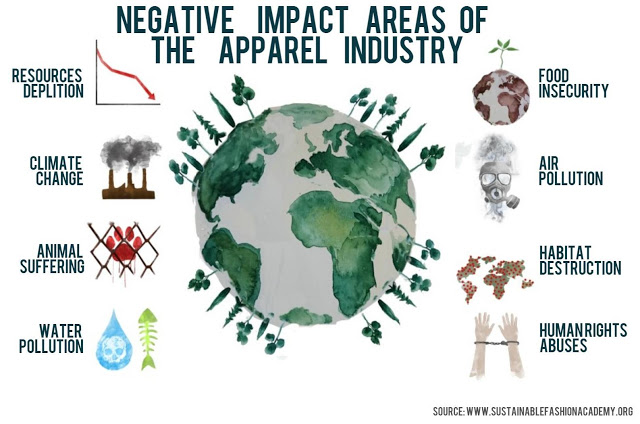Hey earth muffins! The term “fast fashion” has been quite popular these days as sustainability continues to be a focus of the news. When I started my journey towards living low waste last summer, I only vaguely knew what the term meant… 🤷♀️ So, I wanted to share a quick post explaining what “fast fashion” is and how you can (and should) avoid it. Let’s jump right into it! 😊
 |
| Pin now to read later! |
According to the dictionary, fast fashion is “inexpensive clothing produced rapidly by mass-market retailers in response to the latest trends”. Consumers are typically drawn to these companies because the clothing at the store changes so quickly; the customer is able to stay “trendy” while (often) doing so at an affordable price. Many of the brands at the mall and other well-known retailers fall into this category. Don’t believe me? Here is a list of some prime examples:
Suggested by the list above, a huge percentage of the stores people buy their clothes from are considered “fast fashion”. Why is this a bad thing? Here are some reasons that might convince you:
1. Fast fashion isn’t actually saving you money – Not only do you spend smaller sums of money more often (which definitely adds up!), the cheap clothes that you purchase don’t last as long. This forces you to go out and buy even more fast fashion. Rinse and repeat. 😣
2. It is HORRIBLE for the planet – Think about all of the clothes that are thrown away just because they are “out of style” when the next trend is created. Think about all of the water it takes to produce these garments when many countries still do not have drinking water. Think about the amount of fossil fuels it takes to transport these clothes all over the globe. Think about the materials they are made of and the pesticides that are used on these genetically modified plants. Think about the plastics used in the cheap materials of the clothes (you think your clothes don’t contain plastic?) that ends up in the earth or the ocean.

3. It supports unethical business practices – Supporting fast fashion often means supporting unethical treatment of labor and resources at the supply chain level. There is a huge trend towards shipping out production to cheaper countries, which negatively affects the business and economy of our own country. This also cuts out jobs in the US. Do you really want to support that?
4. Fast fashion has ruined how we see clothes – I found it interesting that this article points out the fact that fast fashion has lowered the value of how we see clothes. Now that everything can be replaced so easily, we don’t take the time to treat our clothes with respect or try to repair them when something gets ripped or broken. That is honestly really sad, as I feel we are all losing a sense of our own style by buying into what the industry says is “trendy”.
I will say it right now: avoiding fast fashion is extremely difficult because it is often the only option. Our culture has shifted to the new norm that fast fashion is how we get our clothes… And that needs to change! If you are looking to avoid fast fashion, here are some of my suggestions:
1. Buy less! If you can’t give up fast fashion completely, then just buy less of it.
2. Shop second hand. I don’t remember the last time I purchased a new piece of clothing in the past year, and my style hasn’t changed or made me look any different than I usually would. Try to avoid fast fashion brands at the thrift store too – remember that they are super cheap, so it is better to find higher quality pieces… If you want more of my top tricks for shopping second hand, check out that post here!

3. Buy from truly sustainable brands (but be careful of greenwashing!).
4. Try to mend or tailor your clothes instead of throwing them away. 🧵 Make them last as long as possible!
5. Donate any clothes that are completely wearable. Even if you can’t wear them, someone else will gladly do so (which also means they are skipping out on fast fashion too!). 😃
What are your thoughts on fast fashion?
Love,
Jenna ♥





It took me a long time to even think about how fast fashion impacts the environment. Now, I try to limit what I purchase from stores like H&M and Forever 21. They used to be my go to's…so it's a challenge for sure!
the-creationofbeauty.blogspot.com
Nice work.
fast fashion
I found it impossible to avoid fast fashion. I am a mother of three, including two disabled teen/adults. I have found that the so-called “green” cotton companies sell ONLY wildly overpriced “organic” cotton T shirts and sweats. (Mate) I bought several $64 organic T shirts, and they didn’t last a month, had holes in them after ordinary wear and washing in the washing machine. There is nothing available to wear to a job or a business meeting, only “lounge clothing” which I have limited use for, no matter how well made it claims to be. I try to buy clothing that is at least 99% cotton (excluding zippers, etc.) for myself and my children, and it is increasingly difficult. Everything in the stores is at least 50% polyester, acrylic, nylon, acetate, or rayon. even choices (such as T’s and sweats) that traditionally have been 100% cotton. I’ve found quality cotton work clothes for myself (I’m talking about garden work) from Mail order outfits such as Duluth Trading and LLBean, and they are durable and made to fit people who actually do physical work (don’t show parts of you you’d rather no show while you are bending over to dig or pull weeds), but it’s average $60 for a pair of pants and $100 for overalls. And not everything they sell is environmentally friendly. I have to make exceptions for outerwear, it’s pretty difficult to make something rain/sleet/frost/waterproof and also compostable. I’m very frustrated with how difficult it is to avoid “fast fashion”. I’ve even found clothing (T shirts) marked 100% cotton at Walmart, that I’m almost sure isn’t. It doesn’t feel like cotton and it’s imported from obscure 3rd world countries.